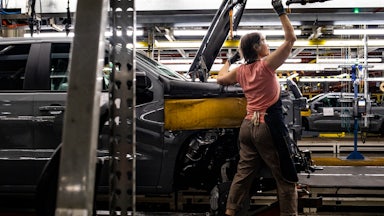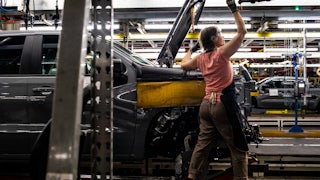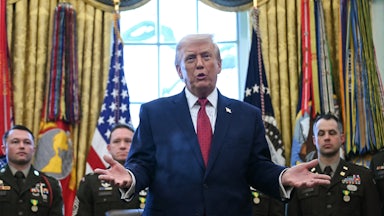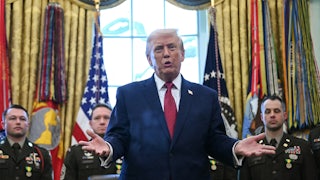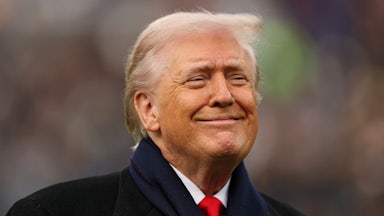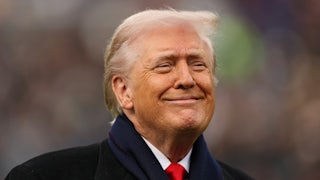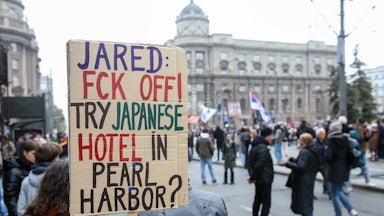In the weeks since taking office, President Donald Trump and his billionaire ally Elon Musk have taken drastic steps to slash the federal workforce. In turn, this has spurred a bevy of lawsuits and ignited renewed vigor among government employee unions.
The first month of the second Trump administration has been a period of constant upheaval for federal workers, with employees routinely receiving conflicting information about hiring freezes and proposed buyouts, typically followed by court injunctions that compound uncertainty. The federal government employs just over three million people, comprising almost 2 percent of the American civilian workforce.
That workforce is organizing with new urgency. As Mark Smith, president of National Federation of Federal Employees Local 1 in San Francisco, told The New Republic, the response to the Trump administration’s actions has been immediate. There has been a dramatic uptick in employees wanting to join the union in recent weeks, to the point where “we couldn’t process the sign-up forms fast enough,” Smith said.
“I literally just don’t even have time to process them all. It’s the largest growth in membership I’ve ever seen in 10 years,” Smith continued. “I think everybody is getting an education in what unions are for, and why we have them.”
This activity is reflected on a national level as well: The American Federation of Government Employees, or AFGE, the largest federal employee union, has seen a surge in new members in recent weeks. AFGE is also leading several of the lawsuits pushing back on efforts to slash the federal workforce.
On Monday, a federal judge further delayed a deferred resignation proposal by the Trump administration. This came two weeks after the Office of Personnel Management sent an email to two million federal employees granting just nine days to determine whether to stay in their jobs without guaranteed safety and a commitment to be “loyal,” or resign and stay on the government’s payroll through the end of September, even though Congress has not yet appropriated funds for the federal government past March.
On Wednesday, a federal judge lifted the pause on the program, arguing that the unions representing federal employees that brought the suit did not have standing, because they were not directly affected by the administration’s actions, but instead were “challenging a policy that affects others, specifically executive branch employees.” The offer was immediately closed, with a spokesperson for OPM claiming that around 75,000 people had taken advantage of the buyout—far fewer than what Trump and Musk had hoped to entice.
For employees like those in Smith’s union, the net result has been chaos, with each day bringing fresh—and often conflicting—updates and directives. At first, union members believed they would be subject to a hiring freeze, although they learned later in January that the health workers in the Department of Veterans Affairs, or VA, would be exempted. The email from the OPM, which bore the same “Fork in the Road” subject line that employees at X—formerly Twitter—received soon after Musk’s takeover of that firm, sowed further confusion: According to Smith, some workers simply reported the initial email as a phishing attempt, because they believed it was a scam.
“Folks at first were just confused and shocked. And then very quickly that started to turn into anger and frustration that our new administration was sort of implying things like, we were low productivity workers,” Smith said. He added that most members of his union did not appear interested in the proposed buyouts, unless they were probationary employees concerned about being laid off, or workers close to retirement. Then, after a week of confusion, the administration made clear that roughly 200,000 workers in the VA would be exempted from the buyout proposal.
“It was just like a lot of confusion and stress and anxiety for people for absolutely no reason,” Smith continued.
While the deferred buyout program is perhaps the most high-profile of Trump’s efforts to reshape the federal workforce, other actions have had significant consequences for government employees, such as essentially dismantling the U.S. Agency for International Development. There, a court order has temporarily stalled the shutdown of the agency, offering a brief reprieve for thousands of workers. Meanwhile, all across the constellation of civil service agencies, employees are watching as the Department of Government Efficiency, an agency run by Musk and staffed largely by young men with no government experience, is accessing sensitive government information and issuing directives to slash the budgets of multiple departments. Some of these measures by the Trump administration have been blocked or delayed in federal court.
“One thing to take from this episode is why unions are essential to preserving democracy,” said Michael Podhorzer, a senior fellow at the Center for American Progress and former political director of the American Federation of Labor and Congress of Industrial Organizations. Whereas individual employees don’t have the resources to protest the actions taken by the administration, federal workers’ unions are able to challenge them with lawsuits, Podhorzer continued.
Although the majority of union members supported former Vice President Kamala Harris in the 2024 election, unions are not a political monolith; indeed, Trump made inroads with some private sector unions during the campaign. Everett Kelley, the AFGE president, estimated on a call with reporters this week that around 30 percent of members voted for Trump—although he added that “they did not vote to tear down these various agencies.”
“Once an election is over, union members are very attuned to their interests as workers,” said Podhorzer, citing previous union opposition to the Bush and Reagan presidencies, even as members might have supported those Republican presidents individually. “It’s a wrong assumption that just because they voted for Trump that they’re going to sit by when their own economic interests are challenged.”
Kelley said on Wednesday that the ruling lifting the pause on the resignation program was a “setback in the fight for dignity and fairness for public servants,” but added that it “did not address the underlying lawfulness of the program.”
Beyond lawsuits, government employee union members may have little immediate recourse for protesting administration actions. In theory, federal workers could organize a walkout, but they would be risking termination; unlike private sector employees, they are not legally permitted to strike. But Cathy Creighton, director of Cornell University’s School of Industrial and Labor Relations Buffalo Co-Lab, also noted that federal workers live all over the country—meaning that their economic interests affect communities in both red and blue states, and so lawmakers of both parties would theoretically be invested in their treatment. For their part, Smith said that his union has been focused on education in the wake of the Trump administration’s actions, and will participate in a “day of action” later this month organized by the nascent Federal Unionists Network, composed of government employees working to raise awareness.
Trump’s actions have been so galvanizing for federal unions, Creighton continued, because of the “belittling and humiliating treatment” they are now receiving. “They work, by and large, very hard, and yet to be told that they should leave their job because [of the idea that] it’s a place where people are lazy and don’t work hard is insulting to people who’ve given their career—not just to a job—but to their government and to the nation,” explained Creighton.
That’s certainly how Smith feels. While Trump and DOGE “would like to portray federal workers as bureaucrats who push paper all day,” he said, “we do incredibly important work that benefits the American public every day.” Smith represents workers at the Veterans Health Administration; the VA employs the most civilian workers of any government agency, and most of those employees work for the VHA. (The Department of Education, which DOGE is working to slash dramatically, is the smallest Cabinet-level department, with fewer than 5,000 employees.)
Smith noted that since the 1980s, the number of federal workers has largely stayed the same, even though the American population has expanded and federal spending has spiked dramatically. “The workforce hasn’t grown in like, 40 years, and we continue to do incredible work and provide incredible outcomes,” Smith argued. “Despite being often demonized in the press and used like a political punching bag, we’re here because we care about the mission.”
It’s unclear whether the actions against federal workers will be galvanizing for private sector employees as well. Creighton also noted that other actions by the Trump administration would have far-reaching effects for private sector employees, especially the recent firing of a member of the National Labor Relations Board, the agency tasked with protecting workers’ rights to organize. With the sudden termination of NLRB member Gwynne Wilcox last month, the board is unable to weigh in on labor disputes, as it is now down to two members—one less than the quorum required by the Supreme Court. Wilcox is suing Trump, calling her termination a “blatant violation” of the National Labor Relations Act.
“The rest of the labor movement—made up of workers who are not federal employees—are also being impacted by the Trump administration, and if they don’t know that, they’re going to find out fairly soon that they’re in the same boat as the federal workforce,” Creighton said.
She noted that the Teamsters, who were friendly toward Trump in the run-up to the 2024 election, have been working to unionize Amazon delivery drivers, and an August NLRB decision found that Amazon needed to recognize and bargain with the Teamsters. Rendering the NLRB essentially defunct would undermine that effort. Indeed, Amazon-owned Whole Foods is already requesting that the NLRB overturn a recent decision allowing a Philadelphia store to unionize because of Wilcox’s ouster, in an indication of how large companies will continue to react to the Trump administration’s actions.
“Their support for President Trump is not resulting in support for their workers,” Creighton said.
* This article concerns a breaking news story and has been updated.



